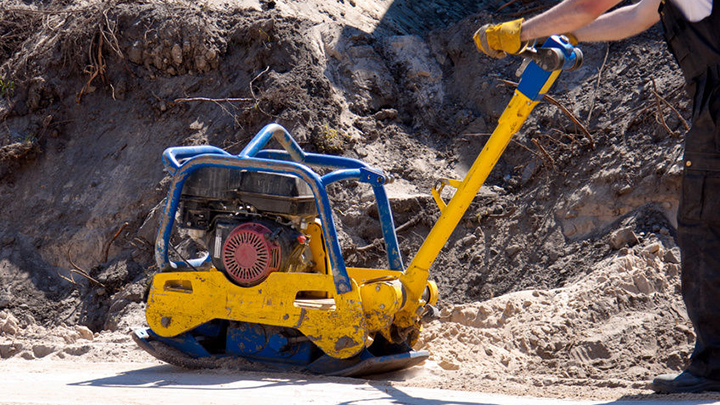The Ultimate Guide to Choosing the Right Plate Compactor

Table of Contents
Introduction to Plate Compactors
What is a Plate Compactor?
A plate compactor, also known as a vibrating plate or a compaction plate, is a powerful construction equipment used for compacting soil, gravel, and other loose materials. It’s an essential tool for various construction projects, including road building, landscaping, and site preparation.
Applications of Plate Compactors
Plate compactors are versatile machines that find applications in a wide range of construction projects. They are commonly used for compacting soil and aggregate in building foundations, driveways, parking lots, and other paved surfaces. They are also employed in utility work, such as compacting the backfill around pipes and cables, as well as in landscaping projects like creating walking paths and patios.
Types of Plate Compactors
Walk-Behind Plate Compactors
Walk-behind plate compactors are the most common type of plate compactor. They are manually propelled and guided by an operator who walks behind the machine. These compactors are ideal for smaller projects and confined spaces, offering excellent maneuverability and access to tight areas.
Reversible Plate Compactors
Reversible plate compactors are designed to move both forward and backward, making them more versatile and efficient in tight spaces. They are particularly useful for compacting soil and materials around obstacles, walls, and other structures.
High-Frequency Plate Compactors
High-frequency plate compactors operate at higher vibration frequencies, typically between 3,000 and 6,000 RPM. These compactors are more effective for compacting granular materials like gravel and crushed stone, as the high-frequency vibrations help to densify and interlock the particles more efficiently.
Factors to Consider When Choosing a Plate Compactor
Compaction Force and Plate Size
The compaction force and plate size are crucial factors to consider when selecting a plate compactor. The compaction force determines the machine’s ability to compact materials effectively, while the plate size determines the area covered in each pass. Larger plate sizes are more suitable for open areas, while smaller plates are better for confined spaces and trench work.
Engine Power and Fuel Type
The engine power of a plate compactor determines its overall performance and productivity. More powerful engines can handle tougher compaction tasks and maintain consistent performance over longer periods. Additionally, consider the fuel type – gasoline, diesel, or propane – based on your project requirements, fuel availability, and environmental considerations.
Operating Weight and Compaction Depth
The operating weight of a plate compactor impacts its compaction depth. Heavier machines can achieve deeper compaction, making them suitable for larger projects and thicker material layers. Lighter compactors are better for shallow compaction tasks and areas with limited access or weight restrictions.
Vibration Frequency and Amplitude
The vibration frequency and amplitude of a plate compactor determine its compaction efficiency. Higher frequencies are better for granular materials, while lower frequencies are more suitable for cohesive soils. The amplitude (the distance the plate travels vertically) also affects compaction performance, with larger amplitudes providing deeper compaction.
Ease of Use and Maneuverability
Consider the ease of use and maneuverability of a plate compactor, especially if you’ll be working in tight spaces or on uneven terrain. Features like reversible operation, ergonomic handle designs, and compact dimensions can greatly improve the operator’s comfort and control.
Top Plate Compactor Brands
Wacker Neuson
Wacker Neuson is a leading manufacturer of plate compactors, offering a wide range of models for various applications. Their compactors are known for their durability, performance, and innovative features like dual-frequency operation and anti-vibration technology.
Toro
Toro is a reputable brand in the construction equipment industry, and their plate compactors are no exception. Toro compactors are designed for ease of use and maneuverability, making them popular choices for residential and commercial landscaping projects.
Multiquip
Multiquip is a trusted name in the construction equipment market, offering a diverse range of plate compactors for different job site requirements. Their compactors are known for their reliability, powerful performance, and innovative features like reversible operation and low-emission engines.
Mikasa
Mikasa is a Japanese manufacturer of high-quality plate compactors that are widely used in various construction projects. Their compactors are renowned for their durability, efficient compaction, and user-friendly designs that prioritize operator comfort and safety.
PME
Wuxi Pinnacle Mechanical Equipment Co., Ltd.(PME)As a first class specialty enterprise we serve global clients. PME specialize on production of plate compactor, tamping rammer, floor saw, concrete vibrator for global construction industry. We also produce engine, generator, and water pump. PME’s strengths are rooted from our strong team and rich resources.
Safety Considerations
Personal Protective Equipment (PPE)
Safety should always be a top priority when operating a plate compactor. Wear appropriate personal protective equipment (PPE), including safety glasses, ear protection, steel-toed boots, and gloves. Ensure that the PPE is in good condition and meets the necessary safety standards.
Operational Safety
Follow all safety guidelines and instructions provided by the manufacturer when operating a plate compactor. Maintain a safe distance from the machine’s path, and be aware of your surroundings at all times. Never operate a plate compactor under the influence of drugs or alcohol, and ensure proper training and supervision for inexperienced operators.
Maintenance and Care
Regular Inspections and Servicing
Regular inspections and servicing are essential for maintaining the optimal performance and longevity of your plate compactor. Follow the manufacturer’s recommended maintenance schedule, which typically includes checking fluid levels, replacing air filters, and inspecting the machine for any signs of wear or damage.
Proper Storage
When not in use, store your plate compactor in a dry, protected area away from harsh weather conditions. Follow the manufacturer’s recommendations for storage, which may include draining fluids, covering the machine, and ensuring proper ventilation to prevent rust and corrosion.
Conclusion
Choosing the right plate compactor is crucial for ensuring efficient and effective compaction on your construction projects.